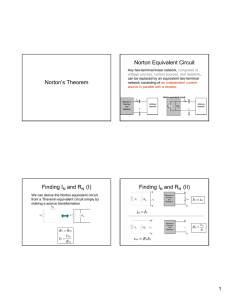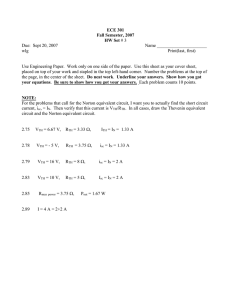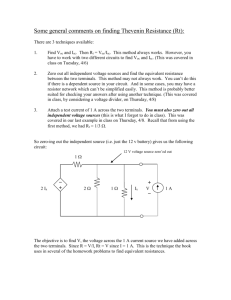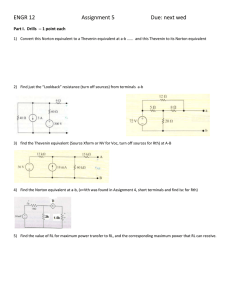Thevenin Equivalent Circuits
advertisement
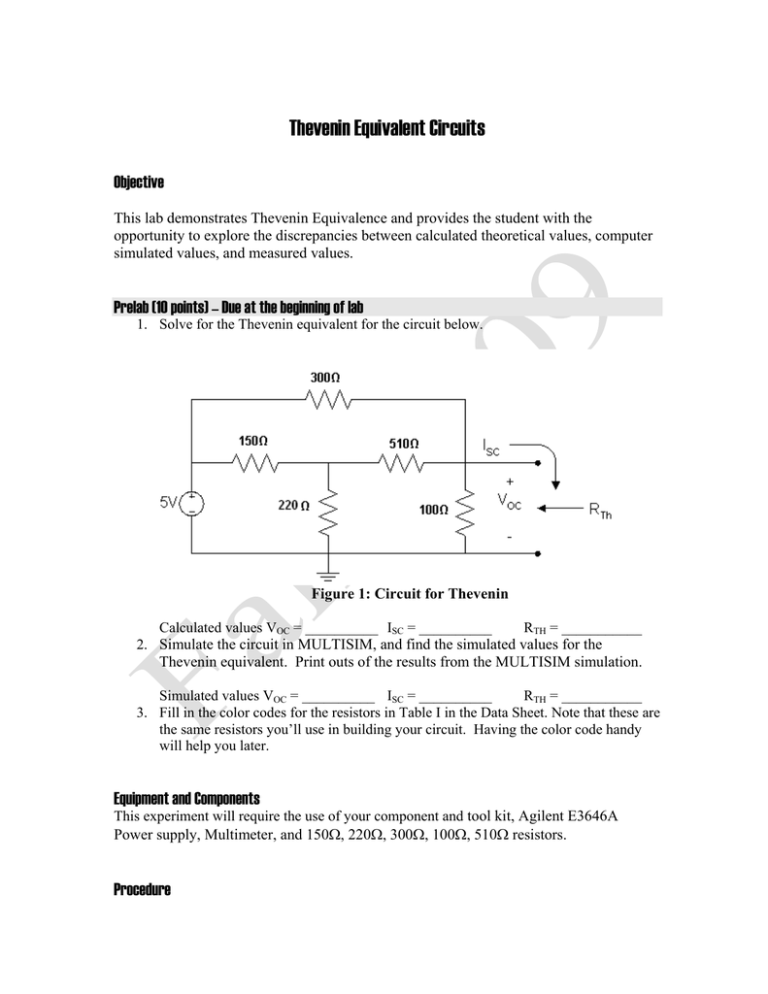
Thevenin Equivalent Circuits Objective This lab demonstrates Thevenin Equivalence and provides the student with the opportunity to explore the discrepancies between calculated theoretical values, computer simulated values, and measured values. Prelab (10 points) – Due at the beginning of lab 1. Solve for the Thevenin equivalent for the circuit below. Figure 1: Circuit for Thevenin Calculated values VOC = __________ ISC = __________ RTH = ___________ 2. Simulate the circuit in MULTISIM, and find the simulated values for the Thevenin equivalent. Print outs of the results from the MULTISIM simulation. Simulated values VOC = __________ ISC = __________ RTH = ___________ 3. Fill in the color codes for the resistors in Table I in the Data Sheet. Note that these are the same resistors you’ll use in building your circuit. Having the color code handy will help you later. Equipment and Components This experiment will require the use of your component and tool kit, Agilent E3646A Power supply, Multimeter, and 150Ω, 220Ω, 300Ω, 100Ω, 510Ω resistors. Procedure Part A Turn on the power supply, and set the voltage to 5 volts. Using the multimeter, measure the actual values of the resistors and record them in the table below. Also measure the voltage of the supply. Now, calculate the Thevenin equivalent using the actual values you entered in the table above. Calculated using actual values: VOC = __________ ISC = __________ RTH = ___________ Part B Next, build the circuit on a breadboard. Do you remember how a breadboard works? Set the multimeter to measure DC voltage, and measure the open circuit voltage. Now, disconnect the power, set the multimeter to measure DC current, connected across the terminals to measure the short circuit current, and turn the power back on.. Caution: Take care with measuring current. Never connect a current meter in parallel with an element that has a voltage across it. This could damage the meter. Power down and disconnect the power supply. Make sure that the power supply is off and disconnected before replacing it with a wire. Connect a wire across the terminals where the power supply had been connected, as shown below. Figure 2: Shorting the Power Supply Now, measure the Thevenin Resistance using the multimeter. Measured values VOC = __________ ISC = __________ RTH = ___________ Part C Figure 3: Circuit for Part C Now that you have had some experience with Thevenin equivalents, calculate and measure the equivalents for the terminals indicated in the figure above. (Use the measured resistor values, not the nominal values). Calculated values VOC = __________ ISC = __________ RTH = ___________ Measured values VOC = __________ ISC = __________ RTH = ___________ Questions 1. Explain any and all discrepancies between the calculated values and the simulated values for the pre lab. Were there any differences? 2. Explain any and all discrepancies between the calculated values, and the measured values for the experiment. Data Sheet Pre Lab Calculated values VOC = __________ ISC = __________ RTH = ___________ Simulated values VOC = __________ ISC = __________ RTH = ___________ Procedure Part A. Table I: Nominal Value vs Actual Value of Components Nominal Color Code Actual Value Value (measured) 300 Ω 150 Ω 220 Ω 100 Ω 510 Ω 5VΩ n.a. Part B. Calculated values VOC = __________ ISC = __________ RTH = ___________ Measured values VOC = __________ ISC = __________ RTH = ___________ Part C. Calculated values VOC = __________ ISC = __________ RTH = ___________ Measured values VOC = __________ ISC = __________ RTH = ___________ Your Name_____________________________ Lab Instructor___________________ Partner Name___________________________ Date___________________________
